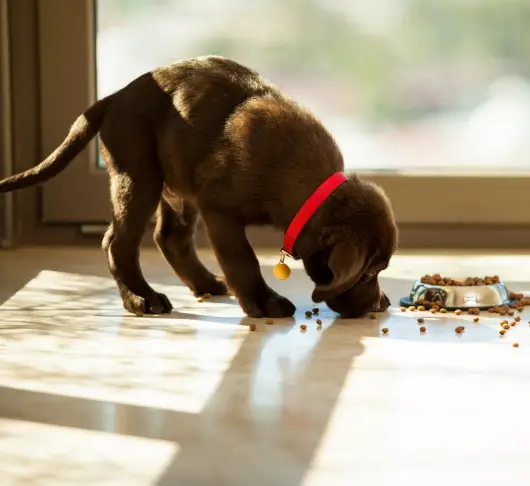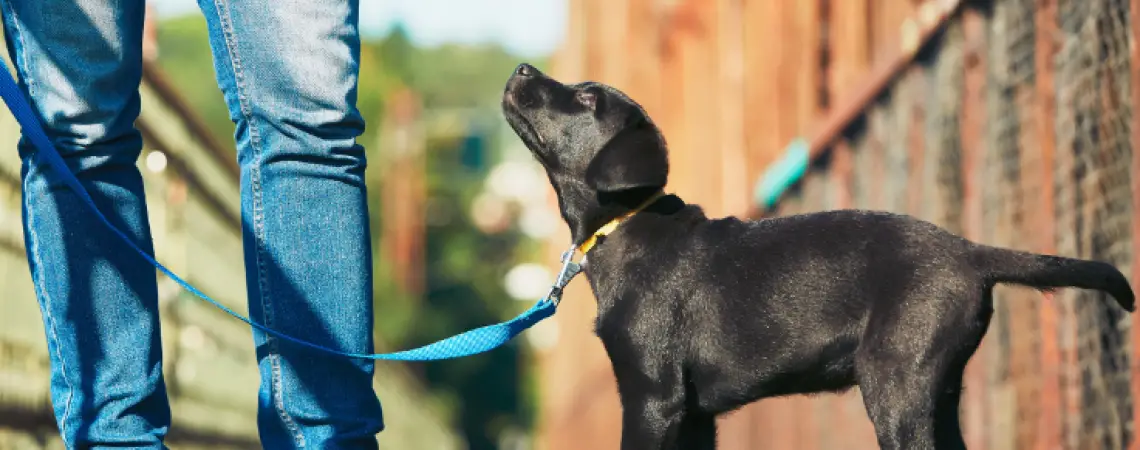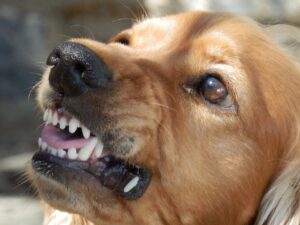Training a new puppy is a lot of work, and for new pet parents, potty training can be one of the biggest challenges of pet ownership.
Dogs don’t speak our language, so sometimes, there’s a miscommunication, causing grief for both puppy and human.
That’s why in this article, we’ll be answering the dreaded “My puppy won’t poop outside” search query, one that many, many pet parents search for every month in hopes of training their new best friend.
My Puppy Won’t Poop Outside! What do I do?
For most puppies, consistency is the key to training. If you’re not consistent with how you do things then your puppy will end up confused. This can lead to undesirable results, such as your dog pooping inside.
Getting your pup on to a new and consistent routine is your best bet for putting the brakes on this behavior. Here’s some guidance to help you.
Create A Feeding Schedule
While it’s tempting to free-feed your dog by leaving kibble on the floor at all times, this is not the best for training. Instead, you should have a feeding schedule for your dog.

This is especially important during the potty training phase, because dogs tend to poop on a pretty reliable schedule. In general, your dog should need to go to the bathroom about 20-30 minutes after eating.
So, step one is to get them on a feeding schedule. For puppies, it’s best to feed them in smaller amounts 3 times a day. Doing this will allow you to keep track of their food intake, and to know when to take your dog out.
This can be a bit of a process, and you may need to take them out several times in 15-20 minute intervals until they poop outside. This is particularly true if they’ve been punished for pooping in the house before as this can give them anxiety about pooping in front of you. Positive reinforcement is the way to go.
Keep an eye on them, and don’t let them wander off somewhere to leave a surprise poop behind the furniture. A kennel or baby gated area is useful for this.
Keep Them Close To You
If your attempts at getting your dog to poop outside were unsuccessful, you’ll have to take them back inside and try again in a bit. As we’ve already covered, creating a “contained” area for them is best. Otherwise they could wander off and leave you a stinky surprise!
Don’t allow them to make an “accident” somewhere else and self-reinforce their bad behavior. Some dogs are easily distracted by all the outside sounds and smells, or they could be reluctant for other reasons, such as insecurity about pooping in busy outside areas.
However, it’s your job to make sure that they realize that outside is the only place to go, and eventually they will. Once this happens, be sure to praise them, give them treats and reinforce the idea that the outside is where they need to be doing their business.
Correct Course When Needed
Punishing your dog can give them pooping anxiety and should be avoided. However, you can try to discourage bad behavior in other ways. For example, if you see that they are about to go on the floor you can say ‘No‘ firmly and run them outside to the grass.
If they’ve already managed to go on the floor when your back is turned then it might be helpful to take their droppings outside and put them in the grass. Allow the puppy to smell the area and try to reinforce that grass is where poop goes and not carpet or tile. Sometimes this can help to get the message across.
Separate potty breaks from fun time
Play time and potty time should be separate. Otherwise, your puppy may be too busy playing to actually do his business! When you make your schedule, have short breaks that are only for bathroom time and then play time breaks as well. If your dog seems distracted or doesn’t poop, go back inside and try again later. Don’t allow them to wander around and play, reinforce the idea that you’re only there for them to go potty.
However, if your dog goes outside and poops right away then allowing for some play time can act as a “treat” and reinforce good behavior. Only let them play after they’ve done their business though!
Note: It can also be helpful to establish a “command” for defecating. For example, when your dog squats down to go you can say “go potty” or something similar. Once the action is completed, praise him and give up the treats if you’ve got ’em!. They will eventually come to learn that when you tell them to “go potty” that it’s time to do their business. This could help them to differentiate between bathroom breaks and play time.
Take Your Puppy Out More Often
Young puppies need to poop a lot. They don’t have the same ability to hold it in like an older dog does. If your puppy poops outside some of the time then this may be what’s going on.
Try to add more bathroom breaks to your schedule and give your puppy the opportunity to go. Every time they are going outside be sure to praise them and even offer a treat that makes it a good experience for them.
You might even try taking them out every hour until you’ve established a routine with them. While this does take a good bit of effort on your part, it’s a good way to break the cycle of them pooping inside.
Watch For The Signs!
Most dogs have some type of signal for when they need to go. Watch for behavior like circling, pacing, whining, or sniffing around. If any of these behaviors are displayed, take your puppy outside immediately to try and get them to go to the bathroom.
Have A Lot Of Patience
Your puppy wants to please you. Unfortunately, it can take them a while to understand what you want. If you get frustrated during training, try to think about ways that you can communicate what you want more clearly.
If you are patient with them and consistent then they will learn. However, yelling, swatting them, or other aggressive behaviors will only confuse and frighten them, causing your dog to poop inside when you’re not looking. Your dog won’t understand why you’re angry, and it will only make them afraid.
My Puppy Keeps Going Potty In The Same Spot!
If your dog keeps peeing or pooping in the same spot in the house then they have, unfortunately, identified this area as the spot to go. They will likely continue to go there until you deny them access and establish a new routine.
Your best bet would be keeping them in a gated area, away from that spot, until you’ve successfully potted trained them. You’ll also want to make sure to deep clean that area with an enzyme cleaner to remove any traces of scent so they don’t get confused again.
My Puppy Hides Somewhere In The House To Poop!
Some animals feel exposed when they’re doing their business and don’t like doing it out in the open. Try to find somewhere outside where there are bushes or something that your dog can hide behind while they go and it may help them to be more comfortable during their house training phase.
If you’ve punished your dog for pooping in the house before then they may also be hiding because the dog may be afraid to poop in front of you. You’ll need to work on building trust with them and watching them like a hawk until they’re comfortable going outside with you watching.
My Puppy Poops In The House At Night!
If your dog only poops inside the house at night then you may want to take them out right before bed. It’s hard for a puppy to hold it in for a long time, and taking them out to go to the bathroom before bed my help. You might also consider feeding them their dinner earlier so that they do not have to go at night.
In closing, it’s a lot of work to potty train a puppy. Most dogs want to please their owners though. So, once they figure out what it is that you want they are normally happy to oblige. Try not to get impatient with them in the meantime! Soon they’ll be potty trained and pooping outside without issue.
Hint – If your pup has made a mess of your house in the process of their training, then an enzymatic cleaner can help you to get things smelling fresh again.





